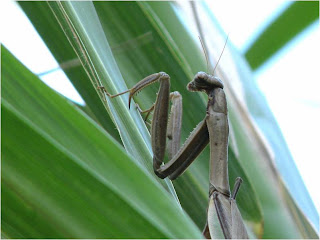(Unless you're a male spider.)
This morning I received an email from my mother asking, “Do praying mantises twist off the heads of male partners and eat them only when being watched—in the wild or in captivity?”
I still don’t know why the question occurred to her at this particular moment—but that wasn’t my major concern: as soon as I saw the email, I had a sudden and pressing need to know whether sexual cannibalism in praying mantises was an artifact of the lab.
First, just a little background on sexual cannibalism: this is a relatively common—or at least not unheard of—act among arthropods, especially spiders and mantids. In both types of species, the females are larger than the males (in the spider species, often much bigger), and so the males are easily/easy prey. –Here’s the typical situation: a male comes up to a female to mate with her, and although they do (usually) mate, at some point--either during or after the mating process--the female eats him.
Why? You might well ask. (Or perhaps this sounds perfectly reasonable to you; I’m not judging.) Sometimes the female “mistakes” the male for prey. Sometimes the female is just hungry. And if she’s likely to produce more—or healthier—eggs if she eats her mate, why not? Animal behaviorists often suggest that this behavior might be adaptive for the male, too: after all, they argue, if females are hard to find and you’re unlikely to get to mate more than once anyway—and you’re more likely to have reproductive success if the female you’re mating with is better fed—then why not go out with a bang? So to speak. Other animal behaviorists say that in fact this sounds like a really bad idea for the male, who is, after all, eaten.
Back to mantids. I pursued a stepwise process of online research to try to answer my mother’s question.
First, I did a general Google search and confirmed (via Snopes.com) my sense that female praying mantises only occasionally eat their mates—it’s not a given of sexual encounter. I then found a slightly later article by the same authors whose abstract has a line that entertained me greatly: “Cannibalism in the mantis was not causally associated with sexual behaviour, but occurred in association with sexual behaviour when females were hungry.” This paper also found that males did their best to avoid being eaten during sex, either by increasing pre-copulatory courtship behaviors or by being really stealthy about their interest (apparently this works)—suggesting that, for male mantids, sexual cannibalism is not adaptive.
Yet another study (because, honestly, wouldn’t you study this too if you could?) tried to actually find out if 1. Females really based their eating-of-males behavior on their own hunger levels (they do) and 2. Females got a reproductive benefit out of it as a result of having better nutrition (they did, in the sense that they “produced heavier egg cases”).
Now what about the artifact-of-the-lab question? It’s hard to say. Many lab trials were conducted via videotaping, so observer presence wasn’t affecting the insects’ behavior. But the authors of this last paper I mentioned did suggest that males in the wild might be eaten less frequently, either because females might find enough to eat so as not to be peckish before mating or because the insects live in such a densely overgrown environment that the males could sneak around in the vegetation and avoid being munched on. As far as I know (though I’m happy to be contradicted), no research has been done to investigate this speculation directly—but I love imagining the male mantises out there in the shrubbery, whispering to each other, “Does she look hungry to you?”
Well, folks, that’s my three-minute introduction to sexual cannibalism (but for a more comprehensive review of the topic, do read this paper). I hope it’s been enlightening. Or possibly disconcerting. Either one works for me.
{A note: I do write all text and take all pictures. Please do not reproduce either without my permission.}











2 comments:
This disquisition is both enlightening and hilarious. So, is this why people go on dinner dates? No one's too hungry after?
Greetings, Olivia,
The following is the poem that stirred up the inquiry. Thanks so much for your wonderful research. I love your blog.
--Caroline
Postcards from Prehistory
by Caroline Maun
I peer into the triangular face
of the mantis, all headlights,
parked on my step like
a Packard. It’s not praying,
it’s preying. If the next male
doesn’t move fast enough,
she will cradle his crisp head
between forelegs and twist.
The turtle, an engine of soil,
pauses on the asphalt,
perhaps in reverie, and becomes--
a speed bump.
At the pier, the child’s line
yields some modest life
at every cast; the crayfish
is surprised by sky,
then unravels, segment by jointed
segment, as he is kicked
toward the bait bucket.
I, too, pulled up life
one queen conch at a time
at the backyard dock
in order to crush them
with a thatch rake, waiting
for the thunder.
Post a Comment